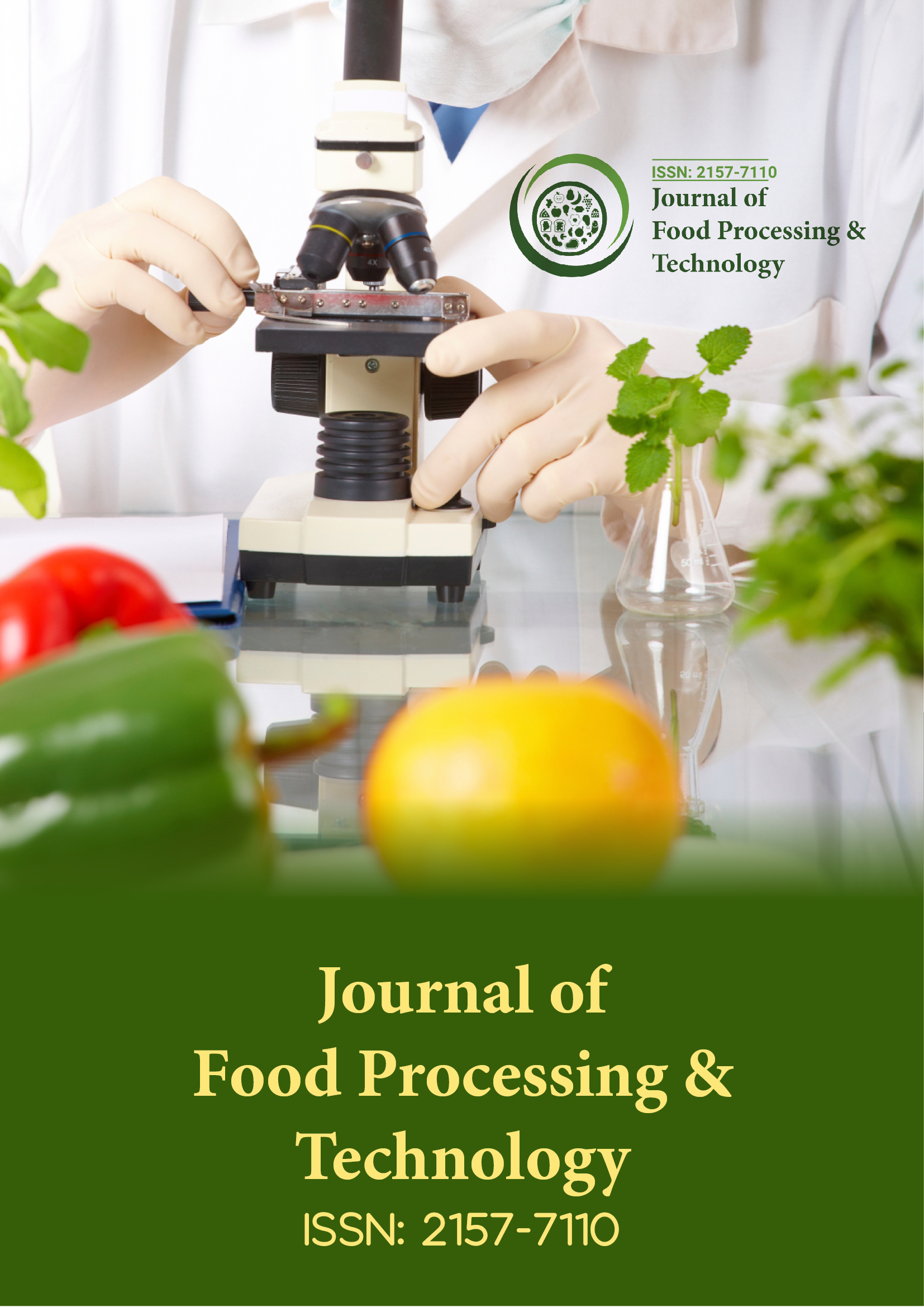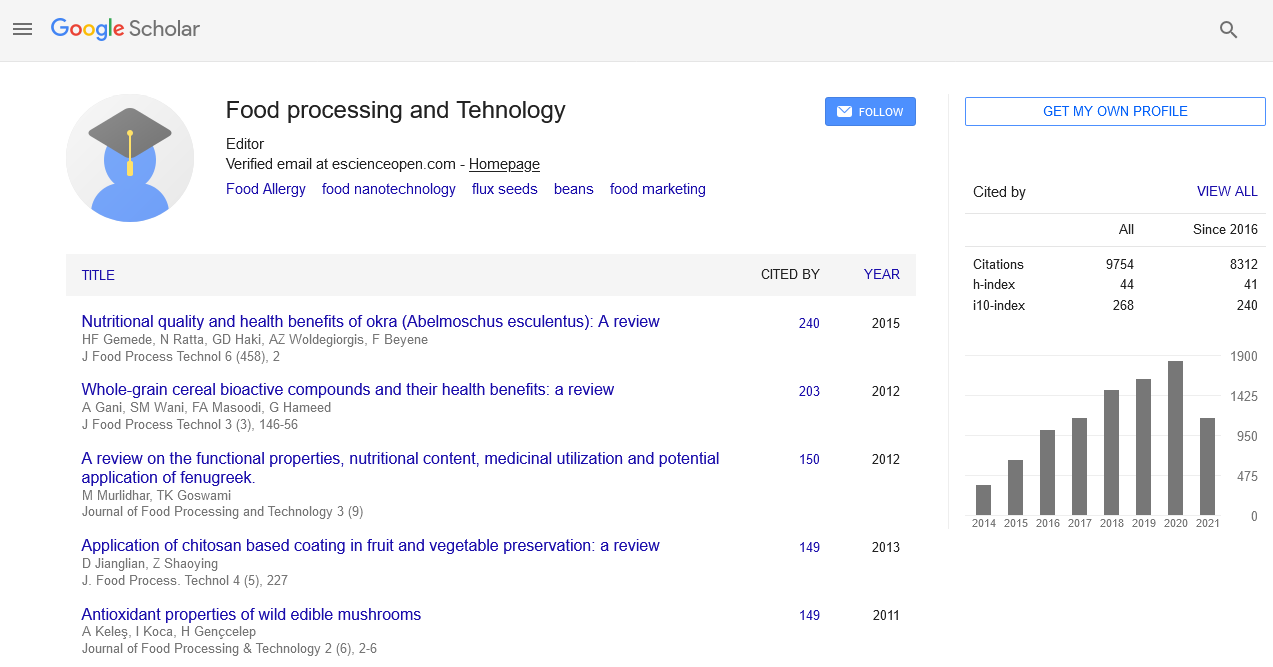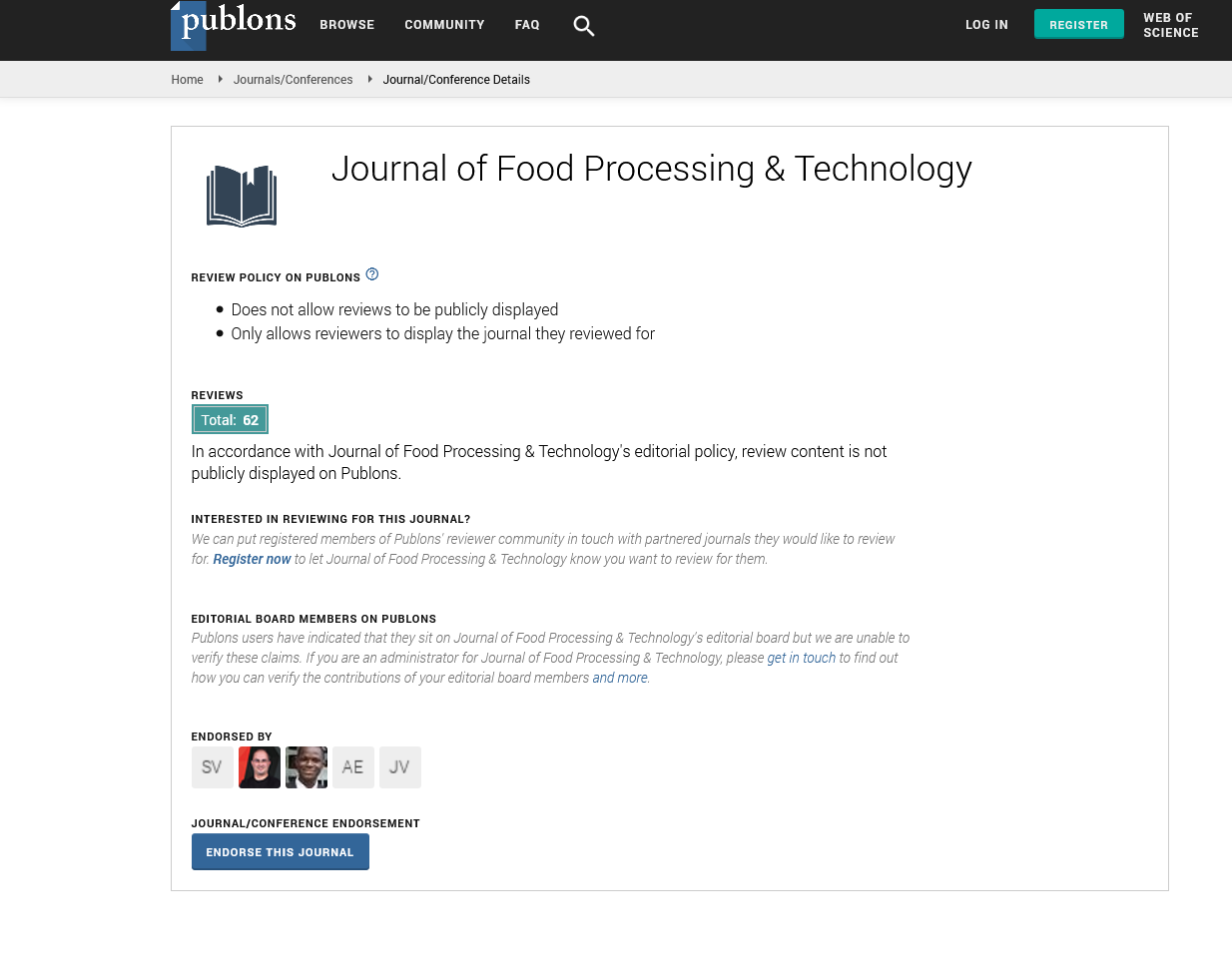Indexed In
- Genamics JournalSeek
- Academic Keys
- JournalTOCs
- China National Knowledge Infrastructure (CNKI)
- Access to Global Online Research in Agriculture (AGORA)
- Centre for Agriculture and Biosciences International (CABI)
- RefSeek
- Directory of Research Journal Indexing (DRJI)
- Hamdard University
- EBSCO A-Z
- OCLC- WorldCat
- Scholarsteer
- SWB online catalog
- Publons
- Euro Pub
- Google Scholar
Useful Links
Share This Page
Journal Flyer

Open Access Journals
- Agri and Aquaculture
- Biochemistry
- Bioinformatics & Systems Biology
- Business & Management
- Chemistry
- Clinical Sciences
- Engineering
- Food & Nutrition
- General Science
- Genetics & Molecular Biology
- Immunology & Microbiology
- Medical Sciences
- Neuroscience & Psychology
- Nursing & Health Care
- Pharmaceutical Sciences
Opinion Article - (2023) Volume 14, Issue 4
Exploring the Benefits of Nanotechnology for Food Packaging
Ganie Younus*Received: 30-Mar-2023, Manuscript No. JFPT-23-21293; Editor assigned: 03-Apr-2023, Pre QC No. JFPT-23-21293 (PQ); Reviewed: 18-Apr-2023, QC No. JFPT-23-21293; Revised: 27-Apr-2023, Manuscript No. JFPT-23-21293 (R); Published: 05-May-2023, DOI: 10.35248/2157-7110.23.14.1008
Description
Nanotechnology is a term used to refer to various technologies and techniques that manipulate objects at the nanoscale. Nanotechnology has been applied to a wide range of industries, including the food industry. Food nanotechnology is the application of nanotechnology to food production, packaging, preservation, and safety. Nanotechnology has the potential to revolutionize the way food is packaged, stored, and transported. Nanoparticles can be used to create barriers that limit the rate of oxygen interaction with food, and to provide antimicrobial protection of food products. Nanoparticles can also be used to create packaging materials that are both lightweight and strong while providing improved barrier properties. In addition to its use in food packaging, nanotechnology can also be used to improve food safety and nutrition. Nanoparticles can be used to encapsulate and deliver nutrients, vitamins, and other beneficial compounds to food products. This can help people get the necessary vitamins and minerals they need while avoiding the unhealthy additives and preservatives often used in food processing. Nanotechnology can also be used to detect contaminants and spoilage in food, allowing for safer and healthier food products. Nanotechnology has the potential to revolutionize food production and packaging, resulting in improved safety, nutrition, and convenience. As nanotechnology continues to be explored and utilized, the food industry is likely to benefit from its many advantages.
Nanotechnology is revolutionizing the food packaging industry with its potential to improve the quality, safety, and shelf life of food products. Nanotechnology-based packaging materials offer a number of advantages over traditional packaging materials. One of the major benefits of using nanotechnology in food packaging is the improved barrier properties of the material. Nanoparticles can be used to produce packaging materials with superior barrier properties that can effectively protect food items from environmental contaminants such as moisture, oxygen, and other gases. This allows food products to remain fresher for longer periods of time. Nanotechnology-based packaging materials are also able to detect and prevent the growth of bacteria, molds, and other microorganisms that can cause food spoilage. This can help to ensure food safety and reduce the risk of food-borne illnesses. In addition, nanotechnology-based packaging materials are often more lightweight and compact than traditional packaging materials. This can help to reduce the amount of packaging materials needed for food products, which can help to reduce packaging costs and improve the overall efficiency of the packaging process. Finally, nanotechnologybased packaging materials are generally more sustainable and eco-friendly than traditional packaging materials. This can help to reduce the environmental impact of food packaging and promote sustainable food production. Overall, nanotechnologybased packaging materials offer many advantages over traditional packaging materials. These materials can help to improve the quality, safety, and shelf life of food products, reduce packaging costs and environmental impact, and promote sustainable food production.
Nanotechnology has been around for many years, but only recently has it been applied to food packaging. This technology has the potential to revolutionize the food industry by making food packaging stronger, lighter, and more resilient. It could also make food packaging more sustainable and environmentally developments in food packaging as a result of nanotechnology. One potential development is the use of nanofibers in food packaging. These nanofibers are incredibly strong and could be used to create packaging that is more durable and able to withstand extreme temperatures. Nanofibers could also reduce the amount of plastic used in food packaging, making it more sustainable. Another potential development is the use of nanomaterials to create active food packaging. This type of packaging would be able to detect when food has degraded and alert the consumer. It would also be able to release preservatives or antibacterial agents to keep food fresher for longer. This type of packaging would be incredibly useful in reducing food waste. Finally, nanotechnology could be used to create smart labels that would provide consumers with more information about the food they're buying. These labels could provide information on the origin of the food, nutritional facts, and other useful information. This could help to empower consumers and make sure they're getting the best quality food possible. Nanotechnology has the potential to revolutionize the food industry and make food packaging more sustainable and efficient. It could also provide consumers with more information about the food they're buying, making sure they get the best quality food possible.
Citation: Younus G (2023) Exploring the Benefits of Nanotechnology for Food Packaging. 14:1008.
Copyright: © 2023 Younus G. This is an open access article distributed under the terms of the Creative Commons Attribution License, which permits unrestricted use, distribution, and reproduction in any medium, provided the original author and source are credited.


